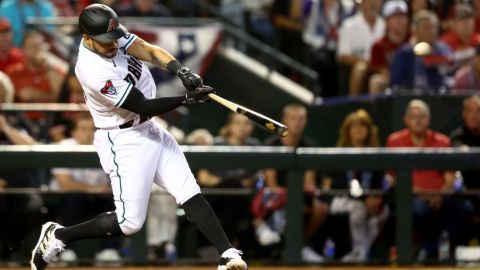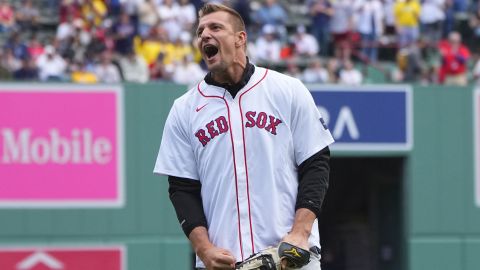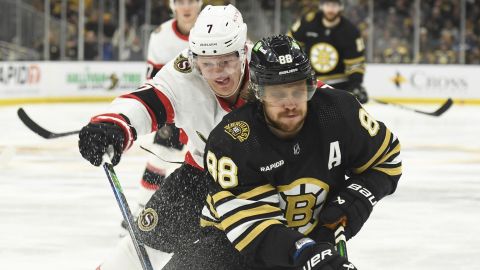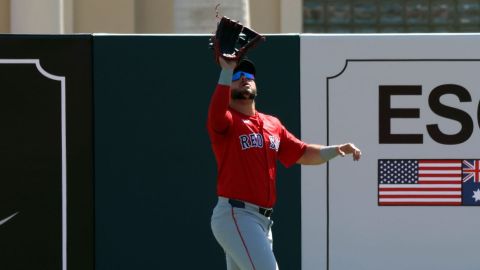 The Red Sox just weathered another stretch where young replacements struggled on the big league stage, with Alex Wilson getting decimated in relief and Allen Webster slipping in his latest spot start.
The Red Sox just weathered another stretch where young replacements struggled on the big league stage, with Alex Wilson getting decimated in relief and Allen Webster slipping in his latest spot start.
But no matter — Boston has the best record in the American League (and almost the majors) heading into Friday’s game against the Oakland Athletics.
Something strange is happening with the team that calls Fenway Park home, and it’s not just the players who were so bad last season being so good this season, or the Sox’ sudden ability to go toe-to-toe with the rest of the majors in several statistical categories. This Red Sox team is different than its 2012 version in many, many ways, with the players and the manager — and what the manager has done with the players — chief among them.
But there’s one other factor that has kept this Boston team as good as it is for so long this season, and it’s one that proves this team’s mettle perhaps better than anything else: the injuries.
Last year’s Red Sox were as snakebit as they come, from the Jacoby Ellsbury shoulder crunch on Opening Day down to the team tipping its cap to the Yankees in a 14-2 loss in the final game of the season. It was a valid defense last year to point out just how many key players on the Red Sox were injured, from both the heart-and-soul perspective (Dustin Pedroia, David Ortiz) to the sheer numbers (teams only wish they could get bonus points if every member of their roster hit the disabled list at one point in a season).
On Sept. 25, when the Red Sox welcomed Pedro Martinez, Kevin Millar and Keith Foulke back to Fenway Park to ride some duck boats in honor of the 2004 World Series run, the Red Sox sent out this lineup: Pedro Ciriaco, Daniel Nava, Pedroia, Cody Ross, Mauro Gomez, Ryan Lavarnway, Danny Valencia, Che-Hsuan Lin and Jose Iglesias. Fans who had forsaken the team early in Bobby Valentine‘s tenure or once the Dodgers trade went through only to come back for the 2004 glory could not have been chastened for thinking that they had stumbled onto a minor league game instead.
But the problem with that 2012 team was never injuries. Injuries — or the lack of bouncing back despite those injuries — were simply a misnomer of a larger problem. That problem has been fixed, as many people predicted, with the arrival of manager John Farrell and whatever other magic potions were poured into this 2013 Red Sox team.
Consider this: In a little more than a month, the Red Sox have made 38 roster moves, with 21 players going up or down. Third base has been in flux for much of the season, with a rotating cast of call-ups taking care of it now. The team’s backup catcher is out for at least a couple of months with concussion issues. The starting right fielder, Shane Victorino, has dealt with hamstring and back concerns all season. The relief staff has been completely blown apart, with closer Joel Hanrahan gone for the season and Andrew Miller just nixed as well.
That’s just a cursory look at the injury bug that has bit Boston this year — but a cursory look is really all that’s needed, because injuries are only considered to have a direct relationship with results when the results aren’t pretty.
The main difference between this year’s Red Sox and last’s is not who Boston has on its roster, or how healthy they are or how long they stay there. The Red Sox have had Ellsbury in and out of the lineup this year just as much as they did last fall, when he finished much of the final months from the pine. They’re calling on just as many minor leaguers, and they’re needing to put them in just as many roles that require strong performances.
The difference with this year’s team is that it knows how to piece together wins even when short a man — and especially when the reinforcements don’t consistently come through. The Red Sox don’t just rely on one Wilson or one Webster to plug the holes, but they can also keep floating when a Wilson or a Webster struggle (or, in Thursday night’s case, a (Steven) Wright succeeds). The Red Sox have called on a variety of minor league players, and the team has been able to keep moving forward even when some of those players struggle.
Furthermore, the players who were once on the line between the minors and the bigs are now separating out. The Red Sox have enough stability and opportunity to either let those players play every day at the major league level or to let them hone their game further elsewhere.
Two players who were in that Red Sox lineup on the 2004 commemoration are now everyday players for the Red Sox (Nava and Iglesias), but that’s not by default, like it was in 2012 — they’re not being forced to play because there is no one else. Nava and Iglesias earned their spots this year on their own merit, when they had to win the job away from equally capable players. Conversely, the Red Sox were also able to send Pedro Ciriaco away this season, when he no longer played up to their big league requirements.
Jackie Bradley Jr. and Will Middlebrooks, who looked like the future of the Red Sox coming into this year, have both regressed since the season began — but Farrell and the rest of the coaching staff are comfortable enough with who they have on the roster that they aren’t rushed to push Bradley to develop at the big league level, and they’re leaving Middlebrooks in the minors for a bit longer to make sure he really has his stuff together before returning.
It’s a luxury that not many teams have with their young players, especially teams coming off such a bad previous year. But the Red Sox put their bets on a special mix of veterans and platoon players coming into this season, and they’re reaping the profits. Farrell has plenty of players who could start on any team, but none of them have to start on the Red Sox. Instead, the team has the flexibility to put players where it would like, and the players in return have had ample time to capitalize on opportunities.
A constantly changing roster has become a nice thing to have rather than the excuse for the team’s poor play.
The Red Sox are a deep, balanced team this year led by a manager who knows how to set the tone and strategize with the best, and it’s shown in many ways. But perhaps the biggest way it’s shown is in how this Boston team could be neck-and-neck with last year’s crew when it comes to rashes of injuries — and how this year’s team just keeps clipping along, as if none of it matters.
The difference between a set of players taking the field and looking like a minor league team rather than a major league team doesn’t have to do with which players’ names are on the roster card. Nava and Iglesias have shown that, and the way the Wilsons and Websters are expected to bring their best each time they get called up this year despite their stuff not quite being there yet has supported it.
The difference is what a team requires out of the players whose names fill its roster card. This year’s Red Sox require a lot, and that’s meant wins.



